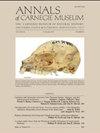A New Genus of Captorhinid Reptile (Amniota: Eureptilia) from the Lower Permian Hennessey Formation of Central Oklahoma, and a Consideration of Homoplasy in the Family Captorhinidae
IF 0.9
4区 地球科学
Q4 PALEONTOLOGY
引用次数: 3
Abstract
ABSTRACT A new captorhinid reptile is described on the basis of materials originally assigned to Captorhinikos parvus Olson, 1954, as well as newly discovered and more complete materials from the same locality. All the specimens are from the lower Permian Hennessey Formation in central Oklahoma. Newly described specimens include a suite of nearly complete skulls allowing confident and thorough description and reconstruction of the skull. The new Oklahoman captorhinid is distinguished from all other members of the family by the unique combination of being the smallest known mature member of the family, the lack of the supratemporal, and possession of multiple maxillary and dentary tooth rows despite its very small size. A new genus, Rhodotheratus, is named to include Captorhinikos parvus, as the new combination, Rhodotheratus parvus (Olson, 1954). A phylogenetic analysis places Rhodotheratus parvus within more basal members of the eureptilian family Captorhinidae. This placement suggests that multiple maxillary and dentary tooth rows must have developed independently at least three times within the family. The interpretation of Rhodotheratus as a small, but well-ossified and mature, adult member of the family demonstrates the first significant example of miniaturization in the family and demonstrates further that the family is a dramatic example of diversification within basal Amniota.俄克拉何马州中部下二叠世Hennessey组虎爪爬行动物新属(羊水目:真爬行动物目)及虎爪爬行动物科同质性的探讨
摘要根据1954年原归属于Captorhinikos parvus Olson的材料,以及同一地点新发现的更完整的材料,描述了一种新的龙目爬行动物。所有的标本都来自俄克拉荷马州中部的下二叠纪Hennessey组。新描述的标本包括一套几乎完整的头骨,允许对头骨进行自信和彻底的描述和重建。新发现的俄克拉何马捕鲸龙与所有其他家族成员的区别在于,它是已知最小的成熟家族成员,没有颞上齿,尽管体型很小,但却拥有多排上颌和下颌牙齿。一个新的属,Rhodotheratus,被命名为包括Captorhinikos parvus,作为新的组合,Rhodotheratus parvus (Olson, 1954)。一项系统发育分析将小红背龙归入爬行类虎蛛科的更基本的成员。这种位置表明,在这个家族中,上颌和牙列至少独立发育了三次。将Rhodotheratus解释为一个小的,但骨化良好的,成熟的,家庭的成年成员,证明了家庭小型化的第一个重要例子,并进一步证明了家庭是基底羊膜动物多样化的一个戏剧性的例子。
本文章由计算机程序翻译,如有差异,请以英文原文为准。
求助全文
约1分钟内获得全文
求助全文
来源期刊

Annals of Carnegie Museum
综合性期刊-动物学
CiteScore
2.50
自引率
18.20%
发文量
4
审稿时长
>12 weeks
期刊介绍:
Annals of Carnegie Museum is a quarterly journal that publishes peer-reviewed short and medium-length original scientific contributions in organismal biology, earth sciences, and anthropology, in 40 by 52.5 pica format (168 by 220 mm or 6-5/8 by 8-5/8 inches). Subject matter must be relevant to Carnegie Museum of Natural History scientific sections or Powdermill Nature Reserve (PNR), preferably with connection to the Carnegie collection and/or personnel. Carnegie Museum staff and research associates receive publication priority, but others are encouraged to submit papers, especially those manuscripts explicitly based on the Carnegie collection.
 求助内容:
求助内容: 应助结果提醒方式:
应助结果提醒方式:


